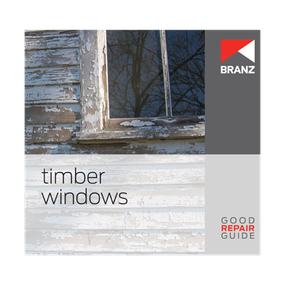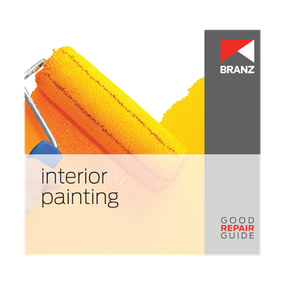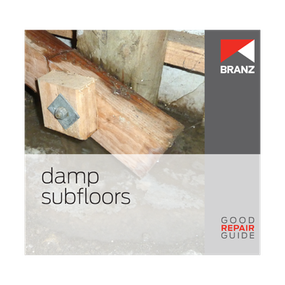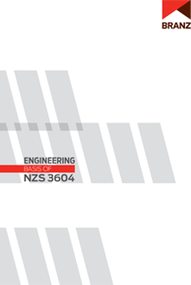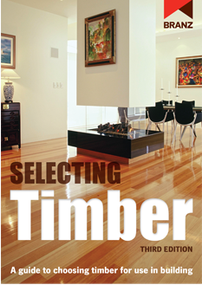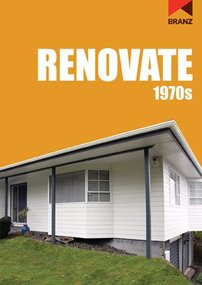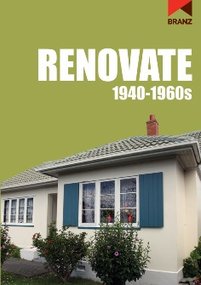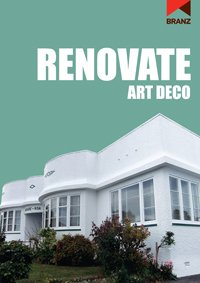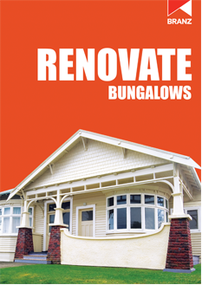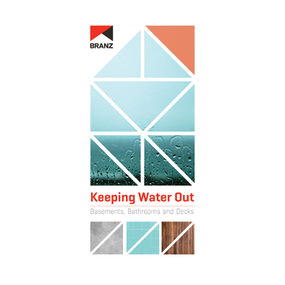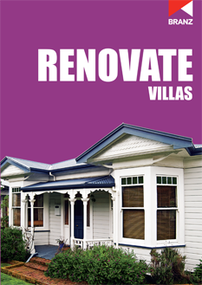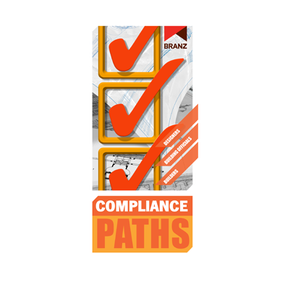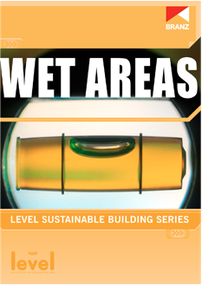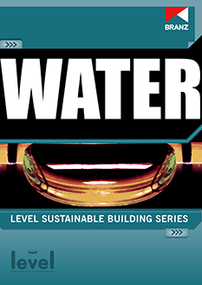Good Repair Guide: Timber windows
Until the 1970s, the main material used for window frames and sashes in New Zealand houses was timber. A large proportion of houses still have timber windows, and these can last for a very long time if well maintained and repaired when necessary.
This Good Repair Guide covers the repair of timber windows using materials and styles to match the existing. It looks at common problems, how to repair and replace windows, rules and regulations and health and safety.
Good Repair Guide: Interior painting
All interior painted finishes within a domestic building deteriorate slowly over time and will require repainting to clean and freshen the surfaces or to continue protecting the substrate. The frequency of repainting depends on the amount of fading caused by UV exposure, damage or wear, and internal humidity levels - high levels of internal moisture that cause condensation to form on surfaces can result in mould growth, staining and paint deterioration.
Painted interior surfaces include ceilings, walls, window frames, doors and door frames, kitchen joinery and trims such as cornices (or scotias), architraves and skirtings. Materials that are likely to have a paint finish include timber, plasterboard, fibrous plaster, softboard, hardboard, fibre-cement, particleboard, MDF and pressed metal ceiling and wall panelling.
This Good Repair Guide highlights common problems, rules and regulations, health and safety, preparation, selecting paint, how to paint, brushes, roller and other applications, spray painting and cleaning up.
Good Repair Guide: Damp subfloors
In a series of house condition surveys that BRANZ carried out on randomly selected houses around New Zealand in 1994, 1999, 2005 and 2010, all of the surveys identified a lack of subfloor ventilation and subsequent higher moisture levels as a problem for houses with suspended floors. Of the houses surveyed, 66% did not meet current requirements for ventilation while 33% had less than a third of the current requirements. The resulting high level of moisture was a significant factor in visible deterioration such as corrosion and decay.
This Good Repair Guide looks at the consequences and causes of subfloor dampness, rules and regulations, health and safety and solutions for subfloors.
Good Repair Guide: Horizontal timber weatherboards
Over time, water entry through poorly installed or maintained weatherboard cladding may cause significant structural damage and other problems long before any symptoms become apparent on the exterior or interior of a building. Regular checks and proper maintenance are critical to ensuring weathertightness.
If a leak or any associated damage becomes obvious, it is advisable to consult a registered building surveyor in order to determine the extent of the problem and necessary repair options.
This Good Repair Guide highlights common problems and causes, types and extent of damage, rules and regulations, health and safety, tools, repairing and replacing weatherboards as well as related documents and standards.
Engineering basis of NZS 3604
This book is intended as a source document for those who need to know the basis for the engineering decisions underpinning NZS 3604 Timber-framed buildings.
NZS 3604 sets out the construction requirements for light timber-framed buildings in New Zealand that do not require specific structural engineering design. By limiting the size of the building and scope of application, a series of solutions are presented, enabling a designer to select an element or detail appropriate to the situation without needing to engage a structural engineer.
Good Practice Guide: Long-run metal roofing (2nd edition)
Long-run profiled metal roofing is commonly used on a wide range of buildings, from houses to large warehouses and industrial buildings.
When correctly selected for the in-use environment, well detailed, well installed and well maintained, long-run metal roofing can provide years of trouble-free service. When poorly selected, detailed and constructed, metal roofs can cause major problems and require extensive maintenance during the life of the building.
This guide covers good roofing practice, detailing and materials and is aimed at designers and specifiers, roofing contractors, building contractors, building owners, building officials, and tutors and students in construction-related disciplines.
Building Basics: Building Code compliance
Making sure that buildings comply with the New Zealand Building Code is a key part of design and construction, yet the process of demonstrating this can be an area of frustration. Building consent applications that don't have enough information that is relevant to the proposed work can cause delays and additional cost to a project.
This book has a focus on residential buildings and covers the steps a designer needs to follow to gather the documentation required and the different options to prove compliance with the performance requirements of the Code.
Selecting timber (3rd edition)
This is a guide for specifying and choosing timber for use in New Zealand buildings, which will be useful to all architects and designers, specifiers and builders working with timber.
As well as covering such key issues as timber treatment and moisture levels, the book features an extensive species data index, with separate sheets for each of 89 species of timber available on the New Zealand market. The data sheets cover key characteristics of each species such as timber strength, hardness and durability, borer susceptibility and typical uses.
Selecting timber briefly covers engineered wood products, plywoods and veneers, looking at their general characteristics, but does not cover specific performance or selection data for these.
House building guide (3rd edition)
This publication is a comprehensive, practical, step-by-step guide and is the ideal reference tool for anyone involved in house building. The easy-to-read format follows through all the key steps involved in house construction right from setting out the site to lining out.
This guide contains practical guidelines for good timber-framed house building, with hundreds of diagrams, easy to follow tables for quick reference and bullet points for easy reading. Informative illustrations show how all the elements fit together.
Renovate: 1970s
Over 279,000 houses were built in New Zealand in the 1970s, a time of expanding suburban development. Architectural styles developed during the 1950s and 1960s influenced mass housing, and a wide range of new materials was used. Split-level homes became common on sloping sites, and many houses included garaging for two cars, with internal access. Architect-designed houses introduced different window styles and rooflines as well as new linings and claddings.
Many houses from this era are little changed since construction. Typical renovation work includes updating kitchens and bathrooms and making improvements to energy efficiency through retrofitting thermal insulation and installing modern space heating systems.
This technical resource covers:
- exactly what defines 1970s style
- how these houses were constructed and with what materials
- modifications they may have had in the decades since they were built
- typical problems and suggested remedies.
This book also takes you through the issue of getting a consent for renovation work, looking at compliance paths and Alternative Solutions.
Renovate: 1940-1960s
Through the 1940s, around 28% of new domestic building work was government-funded state housing. This figure fell to below 10% during the 1960s. This book covers both state and private housing in an era of considerable growth - 262,000 houses were built in the 1960s.
Early state houses may be plain, but they are regarded today as solidly constructed homes that are ideal for renovation. Architect-designed homes of the period introduced many lifestyle features still popular today, such as larger areas of glazing, good indoor/outdoor flow and open-plan layouts.
This technical resource covers:
- exactly what defines 1940-1960s style
- how these houses were constructed and with what materials
- typical modifications they have had in the decades since they were built
- typical problems and suggested remedies.
This book also works through the issue of getting a consent for renovation work, looking at compliance paths and Alternative Solutions. Very brief examples show compliance paths that could be used for renovations such as adding a first floor addition, adding a double-glazed window where there is currently no window and adding an extension to a stucco house.
Renovate: Art deco
The art deco house of the 1930s was a dramatic change to the earlier villa and bungalow. A flat roof, stucco cladding, rounded corners and reduced decoration all contributed to art deco's distinctive style.
These houses are often bought for their style rather than performance. Their stucco cladding and very low-pitched roofs often had weathertightness problems, and without renovation, art deco houses can be cold to live in. Careful renovation can retain the popular style while improving performance and comfort.
This book covers:
- what defines art deco style
- how these houses were constructed, and with what materials
- typical modifications they have had in the decades since they were built
- problems that may be encountered and suggested remedies
- how to get a consent for renovation work, looking at compliance paths and Alternative Solutions
- project and construction planning.
Renovate: Bungalows
Bungalows are the archetypal house of 1920s New Zealand. Builders and architects took ideas from the United States, Canada, India and even Japan and added their own features to create this popular and enduring style. The style is distinctive, with a deep porch, exposed rafter eaves, extended bargeboards and oriel windows. Many bungalows remain largely in their original form, and they are frequently subjects for renovation.
This technical resource looks at:
- what defines a bungalow style
- how they were constructed and with what materials
- the typical modifications they have had in the years since they were built
- typical problems and suggested remedies
- how to get a consent for renovation work, looking at compliance paths and Alternative Solutions
- project and construction planning.
Seminar: Keeping water out
Basements, bathrooms (particularly tiled showers) and decks are known areas of higher risk in terms of potential issues related to water entry and/or migration to adjacent spaces.
This seminar covers the principles of:
- why we need to waterproof effectively
- the requirements of the Building Code, Acceptable Solutions and standards
- waterproofing material options
- waterproofing extent
- key design parameters - the definition of wet areas and splash zones for bathrooms, slopes to bathroom floors and decks
- substrates
- key waterproofing system application requirements such as curing
- key aspects of detailing
- drainage - behind walls, external for decks and internal for bathrooms
- inspection and maintenance
- for bathrooms - specific issues around freestanding baths, preformed showers, level-entry showers, finishes to walls.
Please note that access to this recorded seminar will expire 1 month after purchase.
Renovate: Villas
Many of the country's 85,000 villas, built before World War 1, have already been upgraded and renovated to some extent. In their original state, they are typically cold in winter and draughty, their spaces have a poor relationship to sun and site and their service areas such as bathrooms are not well related to other rooms.
This book is well illustrated with crystal clear drawings showing typical construction methods for framing, roofing, windows and interior building elements. The workings of double hung sash windows alone are shown in six drawings and two photographs.
Typical building materials and construction methods, including match lining, lath and plaster, pressed metal and moulded timbers are explained.
Common problems are outlined, with options given on the appropriate repair or renovation.
Seminar: Wet areas
This seminar aims to enhance the sustainability of the built environment by discussing the design and construction principles for wet areas to ensure that our houses are durable, healthy, comfortable and safe to live in. Topics include:
- defining a wet area
- describing Building Code and performance requirements
- outlining common causes of problems
- describing good design principles for wet area spaces
- detailing of the waterproofing system to prevent moisture transmission and overflow to adjacent spaces
- selecting finishes and fittings that will remain durable in a moist environment.
Please note that access to this recorded seminar will expire 1 month after purchase.
Seminar: Compliance paths
This seminar covers compliance paths for consenting Alternative Solutions. It explains:
- what constitutes an Alternative Solution
- how compliance can be demonstrated
- the level of detail and supporting information required
- the use of testing, comparison with an Acceptable Solution, expert opinion, product certification and producer statements in support of compliance
- options to follow when using past in-service history to show compliance with current Code requirements
- options for assessing an Alternative Solution when received.
Please note that access to this recorded seminar will expire 1 month after purchase.
Level: Wet areas
This publication describes all key aspects of the design and construction of internal wet areas in domestic buildings to ensure that water remains contained within the wet area and the effects of moisture and humidity are effectively dealt with. It contains design tips that help to ensure that wet areas are safe, durable, convenient and sustainable.
This publication covers:
- wet areas and the New Zealand Building Code
- common wet area problems
- flood prevention
- preventing water penetration
- wet area design considerations
- spatial design
- wet area floors
- wet area walls
- fixtures and fittings
- sustainability.
Level: Coatings
With approximately 25 million litres of paints, stains and varnishes used in New Zealand each year, owners and clients are increasingly concerned about occupant health and the impact their buildings have on the environment.
This guide will help building practitioners select thin coatings for most common building materials and components while placing an emphasis on sustainability. It considers the substrate coatings are applied to, maintenance, durability, colour and appearance, all within a sustainability context.
Level: Water
This guide describes ways to reduce water usage by minimising wastage, providing storage for future use and reducing waste water volumes requiring disposal. This publication will help to design homes that use water more efficiently, reduce costs and cope with droughts or storms.
This publication covers:
- domestic water
- minimising water use
- rainwater collection
- landscaping and water use
- wastewater
- greywater systems
- blackwater treatment
- composting toilet systems.




